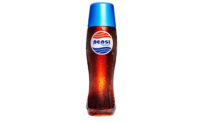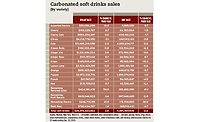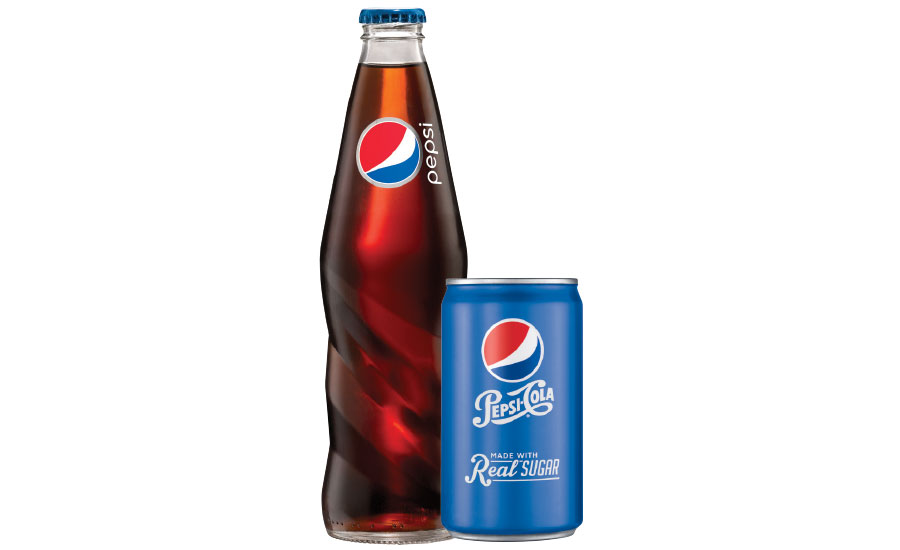2015 Soft Drink Report: Carbonated soft drinks innovate with packaging to appeal to consumers
All-natural soft drinks could be solution to declines

Mini cans and glass-bottle packaging are among the ways beverage-makers can appeal to consumers’ drinking occasions, analysts note. (Images courtesy of PepsiCo Inc.)

Brand owners are rolling out natural mid-calorie carbonated soft drinks. Coca-Cola Life is sweetened with stevia leaf extract and cane sugar. (Image courtesy of The Coca-Cola Co.)

Honest Fizz Organic Golden Ginger Ale is sweetened with a combination of organic stevia and erythritol, resulting in a zero-calorie, all-natural soft drink. (Image courtesy of Honest Tea)

Fruit-flavored varieties from craft soda brands have resonated with consumers, analysts note. (Image courtesy of GuS – Grown-up Soda)

In March, PepsiCo released Mtn Dew DEWshine, a craft, premium soda made with real sugar. (Image courtesy of PepsiCo Inc.)





When walking through the aisles of retail stores, one might notice how different the consumer packaged goods (CPG) environment is compared with previous decades. Emerging brands and categories have contributed to the SKU proliferation that is impacting shelf space. The market also is seeing how the established categories are adapting to the new environment.
Although the carbonated soft drink (CSD) market remains one of the leading categories when it comes to dollar sales, it has faced some challenges within the past few years. According to data from Chicago-based Euromonitor International, the CSD category saw dollar sales of $36.8 billion in 2014. This is down from the $39.2 billion the category experienced in 2012, it reports.
Howard Telford, senior industry analyst of beverage for Euromonitor, adds that retail sales of CSDs were down 3 percent in both volume and dollar sales in 2013-2014 in the United States.
In Chicago-based Mintel’s June 2014 report “Carbonated Soft Drinks – US,” Beverage Analyst Elizabeth Sisel notes that the category has been challenged because of ingredient concerns and being targeted when health and wellness topics surface.
“The carbonated soft drink market is continuing to decline as consumers are driven away by artificial sweeteners, high sugar content and other ingredient concerns,” she reported. “The CSD category is an easy target as other beverages innovate and entice consumers away from sodas. Carbonated soft drinks will have to perfect innovations of their own through marketing, mood association and beverage functionality to stay relevant with consumers.”
Lauren Masotti, client manager of U.S. beverages for Kantar Worldpanel, New York, notes that the declines for CSD penetration have been gradual during the past 20 years. However, it seems as though regular CSD declines have plateaued, while diet soft drinks still are experiencing gradual declines, she says.
The competitive beverage landscape has been a contributing factor, she notes. “In terms of the category more holistically, instead of just CSDs, people are consuming more smoothies, non-dairy [drinks] and enhanced waters, if you want more of water than just a refreshment,” she says. “People are getting smarter about their health and wellness choices, and we see that in the marketplace as these other categories are growing.”
The right selling points
Even with increased competition, CSDs play a strong role in the CPG market, and industry analysts see opportunities for beverage-makers to capitalize on those aspects.
Masotti notes that generational shifts have had an impact on the soft drink market, causing a change in the age entry point. Because the category is not getting the same penetration as in years past, it has affected its growth and engagement, she adds. However, this just means brand owners must utilize the correct messaging to appeal to consumers, she notes.
“It’s about approaching consumers in the right mindset and knowing your consumer is changing,” Masotti says. “It’s about health and a small treat. If you can’t deliver on health, you can use that small-treat aspect.”
Packaging options is another way the category can appeal to today’s consumers, analysts note. “Companies are realigning their package and SKU mix to increase choice,” Euromonitor’s Telford says. “Smaller servings, for example, can simultaneously boost margins while also giving consumers choices in terms of regulating intake and providing portion control.”
Kantar’s Masotti adds that these smaller portion sizes allow consumers to still enjoy the indulgence associated with CSDs but in a more controlled occasion. “It’s a treat, still an indulgent treat, but on a less-frequent occasion,” she says. “You still feel good with the treat because it’s smaller and you’re limiting and budgeting your calories and intake of soda.”
For example, The Coca-Cola Co., Dr Pepper Snapple Group (DPS) and PepsiCo Inc. all offer a variety of their CSD brands in 7.5-ounce mini cans. Purchase, N.Y.-based PepsiCo expanded its mini-can portfolio last year with its Pepsi Made With Real Sugar release. The company also temporarily offered this size for Pepsi Wild Cherry Made With Real Sugar and Pepsi Vanilla Made With Real Sugar.
In addition to the expansion of the mini can, PepsiCo also expanded its plant packaging operations with 12-ounce glass bottles. This type of packaging format also has seen success in the market, Euromonitor’s Telford says. “Glass single-serve bottles of CSDs have shown the potential to add value to the product,” he adds.
Brand owners also are utilizing packaging in their marketing campaigns. As part of its summer 2014 Share a Coke campaign, The Coca-Cola Co., Atlanta, personalized the experience by swapping out its logo on 20-ounce plastic bottles for 250 of the nation’s most popular names among teens and millennials. Available on Coca-Cola, Diet Coke and Coke Zero products, the campaign invited consumers to find names of their family and friends or people they want to know better and share a Coke with them.
Euromonitor’s Telford notes that the company had success in the United States and globally with this package and campaign. The company also noted at the 2014 National Association of Convenience Stores Show that it plans to bring Share a Coke back in 2015 but will expand the number of names on packaging.
Although packaging has been used as a tool to resonate with consumers, brand owners should not forget that taste is king and flavor profiles will be important for the future of the CSD category.
In Mintel’s report, the market research firm found that enjoying the flavor is the top reason consumers purchase CSDs, with 58 percent of the surveyed 1,782 internet users aged 18 and older who purchased soft drinks or seltzer waters in the past three months citing this as their top reason. Other top responses were for refreshment at 53 percent and to have a treat at 36 percent. However, with taste still being the top reason for drinking CSDs, this will be a key aspect for brand owners to consider, the report notes. “It will be important to remember that no matter what changes manufacturers make to their formulation to appeal to current health trends, their flavors should not be altered,” Mintel reports.
Flavor innovations also could offer potential to soft drink manufacturers. Kantar’s Masotti notes that capitalizing on multi-cultural aspects like tropical flavors can be found throughout other categories but still has an opportunity within CSDs.
Companies also are targeting multi-cultural consumers through existing brands. For example, Plano, Texas-based DPS Chief Executive Officer and President Larry Young shared in the company’s full-year and fourth quarter earnings call its plans to help its 7UP brand appeal to Hispanic consumers.
“We’re giving 7UP a facelift with new graphics that speak directly to the Hispanic millennial consumer and we’re gearing up for our second year with EDM,” he said. “Once again, [we’re] partnering with the world’s top DJ, Tiesto, and others across seven EDM festivals to drive engagement with our target customers and drive local retail activation. We also know that soccer and music are major passion points with Hispanics, so we’re teaming up with star athletes like Tim Howard and Hector Hirano to celebrate the summer of soccer and sponsoring the 16th annual Latin Grammys, offering consumers a chance to win a trip to the show and an exclusive 7UP concert.”
In the call, Young also noted that the company’s Ten platform continues to bring lapsed occasions back to the CSD category.
Analysts explain that mid-calorie formulations, like DPS’s Ten platform, have allowed beverage manufacturers to retain consumers, but results have been mixed. Kantar’s Masotti says the mid-calorie beverages have helped attract male consumers, but the segment hasn’t grown as quickly as analysts and companies previously thought it would.
“The CSD industry saw that they were losing people and wanted to give consumers an alternative, so not a diet soda, but a mid-calorie,” she says. “You’re going to save some calories but you’re still getting that taste [and] that flavor of a regular soda. That was a really good tactic, [but] I don’t think it picked up as much as we thought [it would].”
Masotti notes that this ties into the regular vs. diet consumers. “Diet consumers, in terms of their consumption, they drink a lot more of the category in the average week,” she says. “… Although the category is declining a bit quicker, there are still heavier[-consumption] consumers here. There are still habitual consumers. When you think about mid-calorie, that’s kind of the CSD market’s response to people wanting to leave the category altogether and giving them a mid-calorie option on the way out.”
Another way beverage-makers are exploring the mid-calorie segment is through natural sweetener combinations. For example, The Coca-Cola Co.’s Coca-Cola Life, which expanded to national distribution in late 2014, and PepsiCo’s Pepsi True, which launched last year on Amazon, are both made with a blend of cane sugar and stevia leaf extract.
“The implementation of stevia in Coca-Cola Life and Pepsi True represent an attempt to bring stevia as an ingredient into mainstream CSDs,” Euromonitor’s Telford says. “It’s too early to tell if this will remain a niche segment or a real transformation of low-calorie products.”
Honest Tea, a Bethesda, Md.-based independent operating unit of The Coca-Cola Co., also has been working with stevia in the CSD arena, but in a zero-calorie format. Recently, the company released Honest Fizz Organic Golden Ginger Ale. Combining organic ginger and other flavors, Organic Golden Ginger Ale is sweetened with a combination of organic stevia and erythritol. The company also announced that all products within the Honest Fizz portfolio now are certified organic. When the Honest Fizz line debuted in 2013, only the Root Beer variety included organic stevia and erythritol. However, the plan was to eventually transition the entire line over to organic ingredients, the company says.
“When we launched Honest Fizz three years ago, we made a long-term commitment to convert the line over to organic certification,” said Seth Goldman, founder and TEAeo of Honest Tea, in a statement. “We’ve been working with our ingredient and packaging suppliers to make our entire Fizz line affordable, organic and delicious. It’s another step in our ongoing journey to democratize organics.”
Goldman noted that zero-calorie Honest Fizz, as well as the brand’s recent ready-to-drink tea releases, is an extension of Honest Tea’s support for the American Beverage Association’s (ABA) Balance Calories Initiative. Working with the Alliance for a Healthier Generation, America’s leading beverage companies have set a goal to reduce the amount of beverage calories consumed by each person nationally by 20 percent by 2025, the ABA states.
Among the early efforts of the Balance Calories Initiative was the launch of the ABA’s Mixify campaign, which encourages teens and families to balance their calories based on what they consume and their activity for the day. The Coca-Cola Co., PepsiCo and DPS are among the companies participating in the overall initiative.
Small scale, strong impact
Although mass-produced CSDs have experienced some challenges within the past few years, some smaller craft soda and all-natural brands have begun to resonate with consumers.
For example, Fortune reported in a June 2014 article that Culver City, Calif.-based Zevia had sales of $90 million in the past 12 months. Zevia’s CSDs varieties all are sweetened with stevia and monk fruit extracts, resulting in a zero-calorie product. Even though the brand offers popular flavor varieties like Cola, Grape and Ginger Root Beer, it also has added less mainstream offerings including Grapefruit Citrus and Strawberry.
Kantar’s Masotti says the flavor trends within all-natural sodas have proven to be successful with consumers. “People are staying in these all-natural sodas and these lemony-lime and fruit-flavored sodas; they’re staying there a bit longer,” she says. “I think it might be in their head that they’re making a bit of a better decision because it tastes like fruit and has an all-natural flavor to it.”
Masotti adds that the craft soda market is mirroring the craft beer effect because it is giving consumers something different and trendy beyond traditional soft drinks. “I don’t know how impactful that will be to make up for the traditional losses in the CSD category overall, but I definitely think it’s trendy to pick up on today’s consumer, so we’ll keep an eye out on how those perform,” she adds.
Euromonitor’s Telford adds that the growing popularity of craft sodas could be tied to the negative consumer press related to sugar consumption. “One long-term effect of the backlash against sugar consumption may be a push toward naturally fruit-flavored carbonates that are simply less sweet in their formulation,” he says. “While smaller brands — Dry Soda [and] GuS — have had success with lighter, ‘dryer’ flavor profiles, I think we may see some experimentation with this segment from major players in the future.”
Recently, PepsiCo released Mtn Dew DEWshine. “Mtn Dew DEWshine is a craft, premium soda inspired by the brand’s roots in the backwoods of Tennessee,” a company spokesperson says. “It’s a clear, citrus DEW made with real sugar and packaged in clear glass bottles.” Mtn Dew DEWshine is available nationally in 12-ounce single-serve glass bottles and four-packs of 12-ounce glass bottles wherever premium beverages are sold in large- and small-format retail outlets.
Telford notes that traditional CSDs, particularly colas, do not have the same appeal to young consumers now as they have in years past. However, major players are starting to approach this from a craft perspective. For example, last year PepsiCo released Caleb’s Kola, which contains Fair Trade cane sugar, kola nuts from Africa, a blend of spices from around the world, and a hint of citrus. “A new product like Caleb’s Kola [from] PepsiCo is an attempt to win back this important young demographic through a smaller craft appeal,” Telford says.
Established players within the craft soda market also are churning out innovations to appeal to consumers. In late 2014, New York-based GuS – Grown-up Soda added a new Blackberry variety
to its line of craft sodas. GuS Dry Blackberry is lightly sweetened with cane sugar and contains
35 percent fewer calories than an average full-calorie soda, the company says. A 12-ounce bottle contains 95 calories and is gluten free, caffeine free, kosher and vegan.
Beyond flavor expansions, craft soda brands are releasing variety packs to encourage experimentation. Inspired by the popularity of variety packs in the craft beer segment, Seattle-based Dry Soda Co. launched a Summer Discovery Pack mixed pack of its three best-selling natural soda flavors last year.
Dry Soda’s Summer Discovery Pack is a 12-pack of 12-ounce slim cans featuring four cans of Dry Vanilla Bean Soda, four cans of Dry Blood Orange Soda, and four cans of Dry Cherry Soda. In addition, the Summer Discovery Pack offers tasting and pairing notes and recipes to encourage consumers to learn more about Dry Soda and to sip, explore and experiment with the flavors for cocktails, mocktails, food pairings and more, it says.
“Recent market insight has shown that millennials are continually looking for new products, new experiences and new flavors, which in turn is leading to the acceptance of more sophisticated beverage flavors,” said Sharelle Klaus, chief executive officer and founder of Dry Soda Co., in a statement. “Through the Discovery Pack, we hope to introduce new customers to Dry Soda, providing them with a unique sipping experience, and to educate them about our brand and how the sodas can be enjoyed — from an everyday beverage option to a cocktail and mocktail enhancer.”
Preparing for the future
Despite new product and packaging innovations, industry analysts still are bearish about the CSD category’s future.
Mintel is anticipating declines for the category through 2019; however, the market research firm says brand owners can embrace functional and marketing tactics to mitigate this prediction. “The category needs to reverse the negative press and better compete with drink categories through functional innovation and new marketing tactics,” Sisel said in the report. “Carbonated soft drink brands may never be able to compete with the health attributes of other beverages and may continue to be blamed for aiding the obesity epidemic. By admitting this and focusing on ways to instead help consumers monitor their consumption or beneficially contribute to consumers’ lifestyles through other attributes, manufacturers can give users new reasons to purchase without reformulating their products.”
Euromonitor’s Telford adds that the market research firm is forecasting a 2 percent decline in volume sales for the category in the 2014 and 2015 timeframe, with dollar sales flat. “Over 2014-19, we are expecting a negative 1 percent [compound annual growth rate] (CAGR) overall but a positive
1 percent CAGR in value sales as the industry adjusts to a lower-volume environment through better-for-you innovations, higher unit prices and an emphasis on single-serve packaging,” he says.
Looking for a reprint of this article?
From high-res PDFs to custom plaques, order your copy today!












